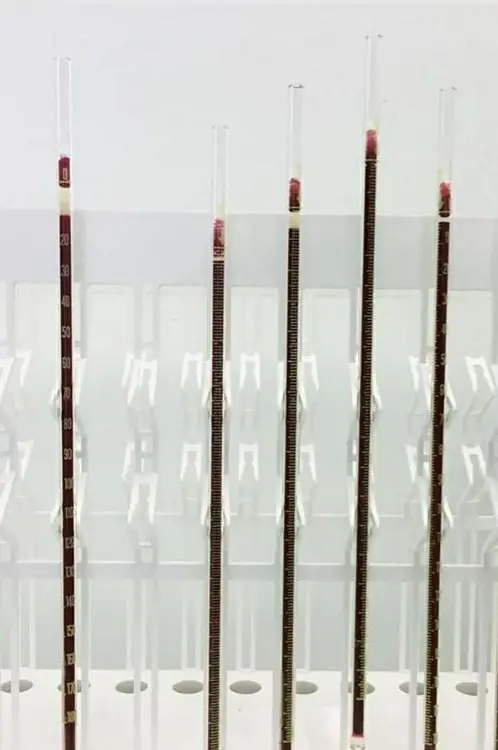Summary :
The Westergren method is widely recognized and commonly employed for determination of Sedimentation Rate value. In this article, we explore the principle, the procedure and the interpretation of this method.
◉ Definition
The Westergren method is the reference technique used to measure the sedimentation rate (ESR) of red blood cells.
This is one of the most popular lab tests, it can detect and monitor an increase in inflammatory activity in your body. However, due to lack of specificity, it must be interpreted in conjunction with clinical signs and other laboratory findings.
The modified Westergren method is a variation of the Westergren method, it uses a shorter tube and a shorter measurement time to determine ESR.
This reference method is recommended by ICSH (International Council for Standardization in Haematology) and selected by the NCCLS (National Committee for Clinical Laboratory Standards).

Westergren tube
◉ Why the test is used
The Westergren method is primarily used for measuring the erythrocyte sedimentation rate (ESR). The ESR is a non-specific laboratory test that indicates the presence of inflammation or other pathological conditions in the body.
The Westergren method allows for the quantification of the rate at which red blood cells settle in an anticoagulated blood sample over a specific time period.
- Diagnosis and monitoring of inflammatory conditions
- Detection of infection
- Evaluation of disease progression
- effectiveness of treatments
- Assess the effectiveness of treatments
◉ Principle and Physiopathology
The Westergren method is based on the principle of gravity sedimentation. It measures the rate at which red blood cells (erythrocytes) settle in an anticoagulated blood sample over a specified period of time.
- In Westergren's method, a vertical tube filled with blood, rendered incoagulable, is placed on a stand.
- In their normal state, red blood cells have negatively charged flat surfaces on the outside, causing them to repel each other.
- People with inflammatory diseases, such as infections or autoimmune diseases, have an increased number of proteins in the blood (immunoglobulins and proteins of the acute phase of inflammation).
- Many of these plasma proteins have positive charges and can effectively neutralize the negative surface charges of red blood cells, allowing the formation of agglutinations (rolls).
- These rolls are denser than individual cells, so they sink to the bottom faster under the influence of gravity.
- The end result is a compact column of sedimented red blood cells with a portion of clear plasma.
◉ Westergren method protocol
The protocol for measuring the sedimentation rate by the Westergren method involves the following equipment and steps:
◉ Equipment : You will need :
- Westergren tube: 2.5 mm diameter tube with a 200 mm graduation. It is open at both ends and can hold approximately 1ml of blood.
- Support: used to hold the Westergren tube upright during the sedimentation process.
- A ruler: to measure the distance traveled by red blood cells.
- A timer.
- VS tube: tube with anticoagulant for blood sampling (the most commonly used anticoagulant is sodium citrate). Usually it has a black cap.
◉ Sampling
A healthcare professional will take a sample of blood from a vein in your arm using a small needle. The amount of blood needed depends on the amount of anticoagulant: 1 volume of anticoagulant + 4 volume of blood.
- Example: a tube that contains 0.4 ml of citrate added 1.6 ml of blood (0.4 × 4 = 1.6)
After collection, gently swirl the tube to thoroughly mix the citrate and blood.
◉ Filling the Westergren tube
Fill the Westergren tube with the blood sample up to the marked level (0), then place the tube (vertically) in the holder in a place protected from heat (20-25 ⁰ C) and vibrations.
◉ Waiting period
Allow the blood sample to sit undisturbed for the specified time interval, usually 1 hour. This allows red blood cells to sediment and separate from plasma, in three steps :
- 1- Aggregation: in the first 10-15 minutes, accumulations of red blood cells and formation of rolls.
- 2- Sedimentation phase: This is the stage where the red blood cells actually fall (30 to 40 minutes).
- 3- Stationary phase (packing): slower fall of red blood cells with settlement of these blood cells at the bottom of the column (10 minutes)
◉Distance measurement
Use a ruler or other measuring device to determine how far the red blood cells have settled from the top of the blood sample to the point where the red blood cells form a distinct layer. This distance is usually measured in millimeters.
◉ Factors influencing
The Westergren method can be influenced by various factors, which may affect the accuracy of results :
- Temperature : Higher temperatures can accelerate the settling of red blood cells, leading to a faster sedimentation rate.
- Hematocrit values : An increase in hematocrit levels, indicating a higher concentration of red blood cells in the blood, generally leads to an increase in blood viscosity.
- Internal diameter and length of the column.
- Time between venipunctur et testing.
- Dilution of blood with anticoagulants.